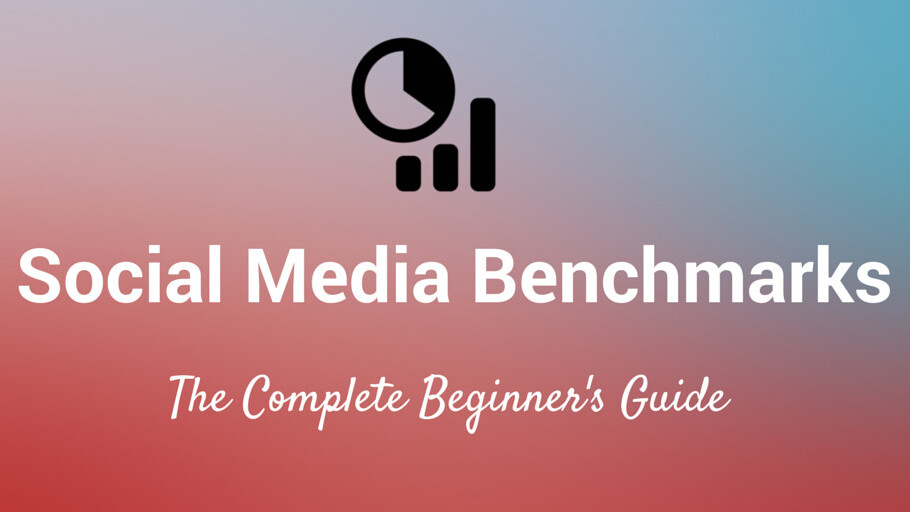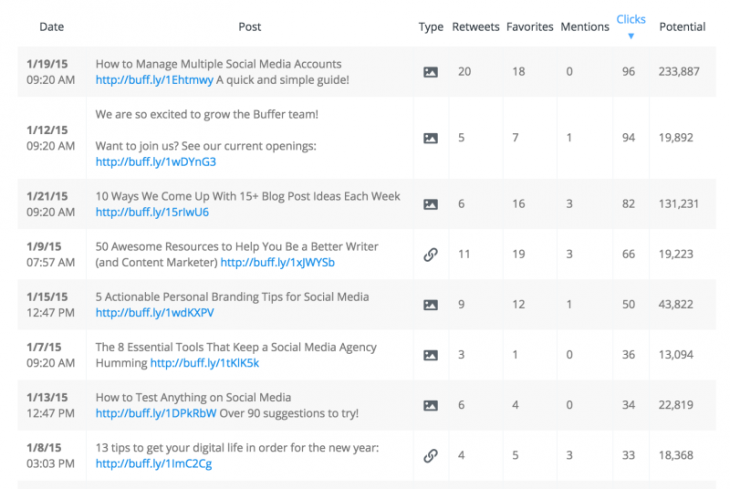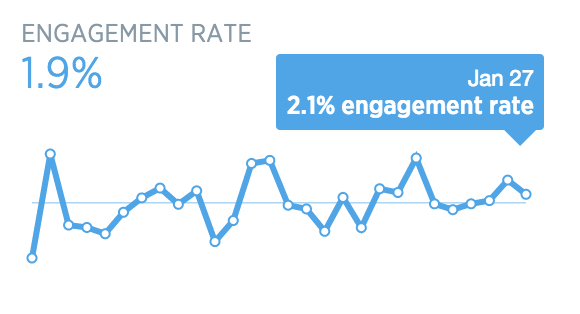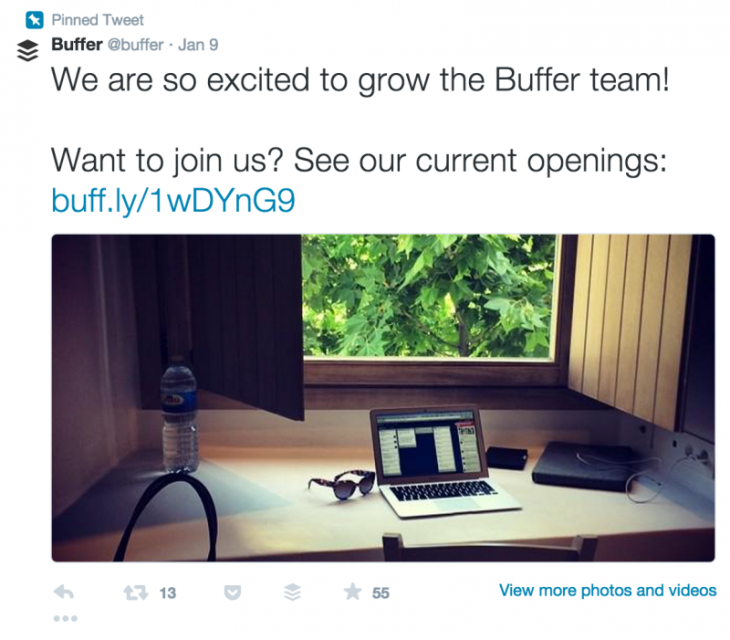
This post originally appeared on the Buffer blog.
If I were to tell you that a recent tweet of mine received 20 clicks, what would you think?
Maybe 20 clicks sounds like a lot based on what you’ve found for your own accounts. Maybe 20 clicks sounds rather lean, considering what you know about clickthrough rates of big brands or your most successful posts.
Checking out the raw numbers of your social media stats, free of context, makes it quite hard to draw any concrete conclusions.
Imagine having a way to tell at-a-glance the success of a social media update. Benchmarking is a way of looking at your stats, side-by-side with a meaningful standard.
Here’s how to add benchmarking to your social media analysis and step-by-step on how to set up benchmarks for your social accounts.
4 ways to benchmark your social media stats
One way that has been really helpful for me to think about benchmarking is splitting it into four key segments:
- Aspirational
- Trended
- Earned
- Competitive
I first heard of this method from Kevin Shively at Simply Measured. His blog post goes into great depth for each of the four types of benchmarks. Here’s a quick explanation:
1. Aspirational Benchmarking: Learning from social leaders.
2. Trended Benchmarking: Setting goals, projections, and standards based on previous activity.
3. Earned Benchmarking: Comparing campaign or promotional efforts against a standard for success.
4. Competitive Benchmarking: Setting goals and baselines for performance and growth based on your direct competitors.
The only edit I’d consider for the list is possibly changing competitive benchmarking to inspirational benchmarking, thereby including influencers in the mix along with competitors.
One of my big questions when I’m benchmarking is whether or not I’m doing it right. Seeing that there are four different ways to do it, chances are good that I’m following one of the four methods above!
Now before we explore each method in depth, there’re a couple questions to ask at the start.
Question 1: Which stats will you benchmark?
The first step for creating benchmarks is deciding which stats matter most to your social media strategy. Social media plans can differ greatly, so it’s likely that your specific metrics will depend greatly on your specific goals.
One possibility, brought about in a journal article by Mullen Advertising, is that you might seek to build relationships with your customers. In that case, quantitative measures like followers/fans and comments/replies would matter greatly.
Traditionally, some of the key metrics on social media involve overall engagement, reach of your content, and clicks back to a website (and conversions beyond the clicks). In these cases, the stats that matter may include:
- Total engagement (the sum of all likes, reshares, replies, and clicks)
- Reach/impressions
- Clicks
Question 2: What should these stats look like?
In my experience, I’ve tried many different ways to glean insights from social media metrics, and I’ve come to see these metrics as falling into three phases.
- Stats per day, e.g. total clicks
- Stats per post, e.g. average clicks
- Stats per follower, e.g. click rate
Stats per day aggregate your total number of, say, clicks into one big number. You can compare Monday’s clicks to Tuesday’s clicks, and so on. It’s great for a big-picture view of your social media success, though it fails to account for variables like the number of times you posted or the day of the week (Monday vs. Saturday, for instance).
Here’s an example of a clicks-per-day graph available at Twitter Analytics.
Stats per post take things one step further, normalizing the numbers according to each post you share. Instead of identifying really good days of sharing, you can now see your very good shares themselves. Often stats per post is calculated as a per-post average from a sample size of data.
In the example below, in looking at the clicks-per-post column, you might choose to find the average clicks based on the data here.
The one missing piece here is that over time your audience may change. If a 200-click post was seen by 400 people, that’s awesome! If that 200-click post was seen by 4,000 people, the story changes a bit.
Stats per follower, then, seem to be the most consistent and true measure of a post’s success. Simply divide your chosen stat by the number of followers. If reach/impression data is available, even better: divide the metric by the number of people who saw the post.
Again, reference Twitter Analytics, the engagement rate graph shows engagements divided by impressions.
1. Aspirational benchmarks
How to set benchmarks to match your top influencers
I love the phrasing of “aspirational” benchmarks—goals and standards that you aspire to achieve. How motivating!
When you create these benchmarks, you’re encouraged to dream big. Aspirational benchmarks are often made by looking at the metrics for industry leaders—Fortune 500 companies, the Inc 5000, or Forbes 100 best small businesses, for instance.
To find the aspirational benchmark that’s right for your brand, you can keep an eye on the latest social media studies, which often use these large companies and large sample sizes for their data. A Google Scholar search is one of my favorite ways to track new social media studies.
Simply Measured puts together monthly studies on how the top brands, both large and small businesses, use social media. Here’s a chart.
2. Trended benchmarks
How to set benchmarks based on your own history
By looking at your own data, you identify a standard that you want to achieve.
In the above sections, I mentioned the value of finding per-follower stats, so let me show you the process of setting trended benchmarks based on these.
With Twitter, you can take either your total follower count or use the impressions data that Twitter gives you via Twitter Analytics. For instance, in the past 28 days, my tweets have received 73,556 impressions and 1,782 total engagements. Dividing the total engagements by the total impressions gives me an engagement rate of 2.4 percent.
My benchmark for Twitter engagement, then, is that 2.4 percent of those who see my tweet should click, favorite, retweet, or reply.
3. Earned benchmarks
How to set benchmarks for campaigns and promotions
This third type of benchmark deals specifically with campaigns and promotions, which are likely to differ from the standard you content you share—both in message and in goals.
The simplest way to set up earned benchmarks is to refer to how your campaigns have performed in the past. The performance of a previously successful campaign becomes the benchmark for your campaigns going forward.
For instance, we often promote our Buffer jobs page on our Twitter account. In my Buffer dashboard, I can see check out the clicks on each of these hiring tweets, come up with an average, and I’ll have a benchmark for future hiring updates. In our case, the hiring tweets average near 250 clicks per post—an awesome benchmark to aim for!
Not only can you dig into your own campaign archives for statistics, you can also learn from the case studies and transparent learnings of others. When you hear about a campaign that performed at a certain level, you can borrow inspiration for setting your own campaign goals.
4. Inspirational benchmarks
How to create benchmarks based on your competitors and influencers
Especially for those looking to gain a foothold in a new industry, inspirational benchmarks can be really useful. They share a bit of DNA with aspirational benchmarks as well—you’re setting standards that will motivate you to perform better.
To create an inspirational benchmark, you’ll need some data on the competitors/influencers in your niche or industry. Chances are you might know a few names of social leaders off the top of your head. If you aren’t sure about the influencers in your area, there are a few tools that can help.
- Perform a BuzzSumo Influencer search for your topic or industry
- Search Twitter bios via Followerwonk.
- Browse LinkedIn’s Pulse discover section to see the names of relevant influencers
Once you’ve identified influencers, the second step is to benchmark their statistics.
Let’s start with Facebook, which makes this process super easy. As a page administrator, you have the opportunity to watch other Facebook pages and to pull the high level stats from these pages directly into your own Facebook Insights.
At the bottom of your main Facebook Insights page, you’ll find the Pages to Watch section, and you can click on the Add Pages button to search and find the pages that inspire you.
On Twitter, you can try a bit more of a manual process. (The process is the same for Facebook stats you might want to benchmark that aren’t shown in the Pages to Watch section.)
Go to an influencer’s profile, and jot down the notes on how their recent tweets have performed, according to the metrics that matter. For instance, if we were to check out Rand Fishkin’s Twitter profile, we’d see that a recent tweet received 34 retweets and 19 favorites. Combined with other posts from his account, you could create an average per-post metric and use this as an inspirational benchmark.
Of course, one of the easiest inspirational benchmarks to set is followers. Look at the other pages and profiles in your industry, average their follower count, and—-bingo!—you’ve got your benchmark for followers for your own accounts.
Summary
Knowing at-a-glance the success of your new social media updates is a huge time saver (and one of our best tips for managing multiple social media accounts). Whichever of the four benchmarking methods you choose, you’ll find a great standard to aim for with your new tweets.
- Aspirational – Shoot for the stars by benchmarking with some of the biggest and best brands
- Trended – Aim to meet the high standards you’ve achieved in the past
- Earned – Track new campaigns side-by-side with successful campaigns from before
- Inspirational – Find inspiring, influential accounts in your field and seek to reach their level
I’d love to hear how this process feels for you and if there are any questions about how to set up benchmarks for your social media strategy. Let me know in the comments! I’d love to chat more.
Read next: Every metric you need to know to measure social media customer satisfaction
Get the TNW newsletter
Get the most important tech news in your inbox each week.











